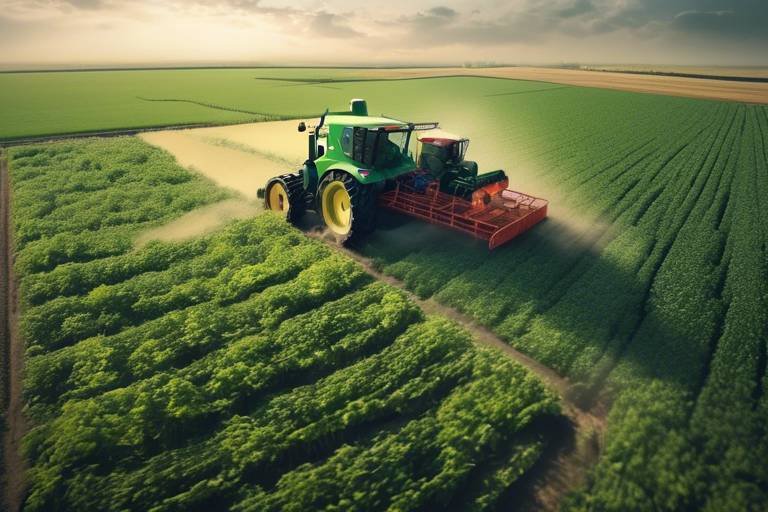Sustainable Agriculture: Benefits of AI and Machine Learning
In recent years, the world has witnessed a remarkable shift towards sustainable agriculture, a practice that not only aims to meet the current food demands but also ensures that future generations have access to the resources they need. This is where artificial intelligence (AI) and machine learning (ML) come into play, acting as powerful allies in the quest for a more sustainable food system. By harnessing the capabilities of these advanced technologies, farmers can optimize their operations, reduce waste, and promote environmentally friendly practices that lead to a healthier planet.
Imagine a world where farmers can predict the weather with pinpoint accuracy, monitor soil health in real-time, and manage water resources efficiently. This is not a distant dream but a reality made possible through the integration of AI and ML in agriculture. These technologies enable farmers to make data-driven decisions that enhance productivity while minimizing their ecological footprint. With the global population expected to reach 9.7 billion by 2050, the pressure on food systems is mounting, making it imperative to adopt innovative solutions that can sustain agricultural practices.
One of the most significant benefits of AI in agriculture is its ability to analyze vast amounts of data quickly and accurately. For instance, AI algorithms can process information from satellite imagery, weather forecasts, and historical crop yields to provide farmers with actionable insights. This level of analysis allows for precision farming, where resources such as water, fertilizers, and pesticides are used more efficiently, ultimately leading to higher crop yields and reduced environmental impact.
Furthermore, AI technologies are not just about increasing productivity; they also play a crucial role in promoting sustainability. By utilizing AI-driven tools for soil health monitoring, farmers can receive real-time data on soil conditions, enabling them to make informed decisions about crop rotation, nutrient management, and organic practices. This proactive approach helps maintain soil fertility and biodiversity, which are essential for long-term agricultural sustainability.
Another area where AI shines is in water management. Machine learning algorithms can predict irrigation needs based on weather patterns and soil moisture levels, ensuring that water is used judiciously. This is particularly important in regions facing water scarcity, where efficient water management can mean the difference between a thriving farm and a barren landscape.
In addition to these advantages, AI also enhances pest management strategies. By analyzing patterns and data, AI tools can identify potential pest threats before they become a significant problem. This early detection allows farmers to implement targeted treatments, significantly reducing the reliance on chemical pesticides and minimizing their environmental impact.
As we delve deeper into the world of sustainable agriculture, it becomes clear that the integration of AI and machine learning is not just beneficial—it is essential for creating a resilient food system. The future of agriculture depends on our ability to innovate and adapt, and with the help of these technologies, we can pave the way for a more sustainable and productive agricultural landscape.
- What is sustainable agriculture? Sustainable agriculture focuses on farming practices that meet current food needs without compromising the ability of future generations to meet their own needs.
- How does AI improve farming? AI improves farming by providing insights through data analysis, optimizing resource use, and enhancing decision-making processes.
- What is precision farming? Precision farming uses AI technologies to analyze data from various sources, allowing farmers to optimize their resource usage for better crop yields.
- How can machine learning help with crop disease? Machine learning can analyze patterns to predict crop diseases early, enabling farmers to take timely actions and reduce pesticide use.

Understanding Sustainable Agriculture
This article explores how artificial intelligence and machine learning are transforming sustainable agriculture, enhancing productivity, and promoting environmentally friendly practices for a more resilient food system.
Sustainable agriculture is more than just a buzzword; it’s a vital approach to farming that ensures we meet our current food needs while safeguarding the resources for future generations. Imagine a world where the soil remains fertile, the water supply is abundant, and biodiversity flourishes. This is the vision of sustainable agriculture. At its core, sustainable agriculture revolves around three key principles: environmental health, economic profitability, and social equity. These principles guide farmers to adopt practices that are not only productive but also responsible.
One of the most fascinating aspects of sustainable agriculture is its adaptability. Farmers are increasingly turning to technology, particularly artificial intelligence (AI) and machine learning, to enhance their agricultural practices. These technologies provide innovative solutions to age-old problems, making farming more efficient and less harmful to the environment. For instance, AI can analyze vast amounts of data to optimize planting schedules, while machine learning algorithms can predict crop yields based on various factors like weather patterns and soil health.
Moreover, sustainable agriculture focuses on maintaining the health of ecosystems. This means employing practices that protect the soil, water, and biodiversity. For example, crop rotation, cover cropping, and reduced tillage are techniques that not only improve soil health but also enhance resilience against pests and diseases. By integrating technology into these practices, farmers can monitor their fields more effectively and make informed decisions that align with sustainable goals.
To fully grasp the impact of sustainable agriculture, it’s essential to recognize the role of community and consumer choices. When consumers opt for locally sourced and sustainably produced foods, they support farmers who are committed to these practices. This creates a positive feedback loop, encouraging more farmers to adopt sustainable methods. In this way, sustainable agriculture is not just a farming technique; it’s a community movement that promotes healthier food systems and a better environment.
In summary, understanding sustainable agriculture is about recognizing its multifaceted approach to food production that balances current needs with future sustainability. As we delve deeper into the role of AI and machine learning in agriculture, we'll discover how these technologies are revolutionizing the way we farm, ensuring that we can feed the world without depleting its resources.
- What is sustainable agriculture? Sustainable agriculture is a farming approach that focuses on producing food in a way that meets current needs while ensuring resources for future generations.
- How does technology play a role in sustainable agriculture? Technology, particularly AI and machine learning, helps farmers optimize their practices, making them more efficient and environmentally friendly.
- Why is community involvement important in sustainable agriculture? Community support for local and sustainably produced foods encourages more farmers to adopt sustainable practices, creating a healthier food system.

The Role of AI in Agriculture
Artificial Intelligence (AI) is not just a buzzword; it’s a game-changer in the agricultural sector. Imagine a world where farmers can predict the weather, monitor soil health, and manage crops all from their smartphones. Sounds futuristic, right? Well, it’s happening now! AI technologies are reshaping the landscape of agriculture by providing invaluable insights and automating various processes. This transformation is crucial for enhancing decision-making and operational efficiency in farming, making it more sustainable and productive.
One of the most exciting aspects of AI in agriculture is its ability to analyze vast amounts of data. Farmers are now equipped with tools that can process information from multiple sources, including satellite imagery, weather forecasts, and soil sensors. This data is then used to create actionable insights that help farmers make informed decisions. For instance, AI algorithms can suggest the best planting times based on weather predictions, ensuring that crops are sown at the optimal moment for growth.
Furthermore, AI-driven systems are increasingly being integrated into daily farming operations. These systems can automate tasks such as irrigation, fertilization, and pest control, which not only saves time but also reduces the environmental impact of farming. By utilizing AI, farmers can optimize their resource use, ensuring that every drop of water or ounce of fertilizer is used efficiently. This is particularly important in a world where water scarcity and soil degradation are pressing issues.
To illustrate the impact of AI on agriculture, consider the following table which highlights some key AI applications and their benefits:
| AI Application | Description | Benefits |
|---|---|---|
| Predictive Analytics | Analyzes historical data to forecast crop yields and market trends. | Helps farmers make better planting and harvesting decisions. |
| Automated Irrigation | Utilizes sensors to determine soil moisture levels and adjust watering accordingly. | Conserves water and enhances crop health. |
| Drone Technology | Employs drones to monitor crop health and assess field conditions. | Provides real-time data for quick decision-making. |
Additionally, AI technologies can assist in pest management. By analyzing data from various sources, AI can identify potential pest threats before they become a full-blown crisis. Farmers can receive alerts about pest infestations, allowing them to take timely action with targeted treatments. This not only minimizes the use of harmful pesticides but also promotes a healthier ecosystem.
In summary, the role of AI in agriculture is multifaceted and incredibly impactful. It enhances productivity, promotes sustainability, and empowers farmers with the tools they need to thrive in an ever-changing environment. As we continue to explore the potential of AI, it’s clear that the future of farming is not just about growing crops; it’s about growing smarter.
Q1: How does AI improve crop yield?
A1: AI improves crop yield by analyzing data related to weather, soil conditions, and crop health, allowing farmers to make informed decisions about planting, watering, and fertilizing.
Q2: Is AI technology expensive for farmers?
A2: While there is an initial investment required for AI technologies, the long-term savings and increased efficiency often outweigh these costs, making it a worthwhile investment for many farmers.
Q3: Can AI help with sustainable farming practices?
A3: Absolutely! AI helps optimize resource use, reduces waste, and minimizes the environmental impact of farming, all of which contribute to more sustainable agricultural practices.

Precision Farming Techniques
Precision farming is a revolutionary approach that leverages the power of artificial intelligence to transform traditional agricultural practices into highly efficient, data-driven operations. Imagine being able to pinpoint the exact needs of your crops down to the square meter—this is what precision farming offers. By utilizing advanced technologies like GPS, IoT sensors, and AI algorithms, farmers can collect and analyze vast amounts of data, leading to more informed decision-making and optimized resource management.
One of the most significant benefits of precision farming is its ability to enhance crop yield while minimizing environmental impact. For instance, by analyzing soil data, farmers can determine the precise amount of fertilizers and pesticides required for each section of their fields. This targeted approach not only boosts productivity but also reduces the likelihood of chemical runoff into nearby water sources, ultimately promoting a healthier ecosystem.
To illustrate the effectiveness of precision farming techniques, consider the following table that highlights some key technologies and their applications:
| Technology | Application | Benefits |
|---|---|---|
| GPS Technology | Field Mapping | Accurate land measurement and planning |
| Soil Sensors | Soil Health Monitoring | Real-time data on nutrient levels and moisture |
| Drones | Aerial Crop Surveillance | Quick assessment of crop health and growth |
| AI Analytics | Data Interpretation | Enhanced decision-making and yield predictions |
Moreover, precision farming utilizes sophisticated algorithms to analyze data from various sources, such as weather patterns, soil conditions, and crop health metrics. This integration of information allows farmers to create detailed maps of their fields, identifying areas that require specific attention. For example, if one section of a field is underperforming, farmers can make targeted interventions, such as adjusting irrigation schedules or applying fertilizers only where needed.
In essence, precision farming is akin to having a personal trainer for your crops. Just as a trainer tailors workouts to individual needs, precision farming customizes agricultural practices to the unique requirements of each field. This not only leads to increased productivity but also fosters sustainability—a vital aspect of modern agriculture.
As we delve deeper into the world of precision farming, it's essential to recognize its potential to revolutionize the agricultural landscape. By adopting these innovative techniques, farmers can not only enhance their yields but also contribute to a more sustainable and resilient food system, ensuring that we meet the needs of today without compromising the resources of tomorrow.
- What is precision farming? - Precision farming is an agricultural management system that uses information technology to ensure that crops and soil receive exactly what they need for optimum health and productivity.
- How does AI contribute to precision farming? - AI analyzes data collected from various sources to provide insights that help farmers make informed decisions regarding crop management, resource allocation, and pest control.
- Can precision farming reduce environmental impact? - Yes, by optimizing the use of resources such as water and fertilizers, precision farming minimizes waste and reduces the risk of environmental pollution.

Soil Health Monitoring
Soil health monitoring has become a cornerstone of sustainable agriculture, and with the advent of artificial intelligence, farmers are now equipped with tools that provide real-time insights into the condition of their soil. Imagine walking into a field and having a detailed report on its health, nutrient levels, and moisture content right at your fingertips! This is no longer a futuristic dream but a reality made possible through advanced AI-driven systems.
These systems utilize a variety of sensors and data analytics to assess soil parameters continuously. For instance, they can measure pH levels, moisture content, organic matter, and even microbial activity. By monitoring these factors, farmers can make informed decisions about when to plant, fertilize, or irrigate, which ultimately leads to healthier crops and improved yields.
One of the most significant benefits of soil health monitoring is its ability to promote precision agriculture. When farmers have accurate, real-time data at their disposal, they can tailor their farming practices to the specific needs of their soil rather than relying on a one-size-fits-all approach. This not only enhances productivity but also minimizes waste and reduces the environmental impact of farming.
Moreover, AI-driven soil health monitoring can help identify potential issues before they escalate into serious problems. For example, if a sensor detects a sudden drop in nutrient levels, farmers can quickly address the issue by adjusting their fertilization strategies or implementing soil amendments. This proactive approach ensures that crops receive the nutrients they need when they need them, fostering a more resilient agricultural system.
To illustrate the impact of soil health monitoring, consider the following table that summarizes key benefits:
| Benefit | Description |
|---|---|
| Improved Crop Health | Real-time data allows for timely interventions to maintain optimal soil conditions. |
| Resource Optimization | Targeted application of fertilizers and water reduces waste and costs. |
| Increased Sustainability | Better soil management practices lead to healthier ecosystems and reduced environmental impact. |
In conclusion, the role of AI in soil health monitoring cannot be overstated. It empowers farmers to adopt more sustainable practices while enhancing productivity. As we move towards an increasingly uncertain climate and growing population, these technologies will play a crucial role in ensuring that we can feed the world without compromising the health of our planet.
- What is soil health monitoring? Soil health monitoring involves assessing various soil parameters to determine its condition and suitability for crop growth.
- How does AI improve soil health monitoring? AI improves soil health monitoring by providing real-time data analysis, allowing farmers to make informed decisions about soil management.
- What are the benefits of using AI in agriculture? The benefits include improved crop yields, efficient resource use, and reduced environmental impact.
- Can soil health monitoring predict crop diseases? While it primarily focuses on soil conditions, maintaining healthy soil can indirectly reduce the risk of certain crop diseases.

Water Management Solutions
Water is one of the most precious resources in agriculture, and with the growing pressures of climate change and population growth, efficient water management has become more crucial than ever. Machine learning algorithms are stepping in to revolutionize how farmers approach irrigation and water conservation. Imagine being able to predict the exact amount of water your crops need, not just for today, but for the entire growing season. That’s the power of AI in action!
By analyzing historical weather data, soil moisture levels, and even crop types, machine learning models can forecast irrigation needs with impressive accuracy. This means farmers can apply water only when necessary, significantly reducing waste and ensuring that every drop counts. For instance, a farmer who used to irrigate their fields on a fixed schedule can now rely on data-driven insights to optimize their watering practices. This not only saves water but also enhances crop health, leading to better yields.
Moreover, these intelligent systems can adapt to changing environmental conditions. For example, if a sudden rainstorm is predicted, the system can adjust irrigation schedules accordingly, preventing overwatering and potential crop damage. This responsiveness is akin to having a personal weather assistant dedicated to your farm, ensuring that you make the most informed decisions possible.
To illustrate the impact of these water management solutions, let’s look at a simple comparison:
| Traditional Water Management | AI-Driven Water Management |
|---|---|
| Fixed irrigation schedules | Data-driven irrigation scheduling |
| High water wastage | Optimized water usage |
| Increased labor costs | Reduced labor through automation |
| Potential for crop stress | Enhanced crop health through precise watering |
As we venture deeper into the realm of sustainable agriculture, it's clear that water management solutions powered by AI and machine learning are not just a luxury but a necessity. They empower farmers to make smarter, more sustainable choices that benefit not only their crops but also the environment. In this way, technology becomes a partner in agriculture, helping us to navigate the complexities of modern farming while conserving our most vital resources.
- What is the role of AI in water management for agriculture?
AI analyzes various data points to predict irrigation needs, helping farmers use water more efficiently. - How can machine learning improve crop yields?
By providing accurate predictions and recommendations based on historical data and environmental conditions, machine learning helps farmers make informed decisions that lead to better yields. - Are there any downsides to using AI in agriculture?
While the benefits are significant, challenges include the initial cost of technology and the need for training to effectively use these systems.

Crop Disease Prediction
In the realm of agriculture, is becoming a game-changer, thanks to the power of artificial intelligence (AI). Imagine being able to foresee potential threats to your crops before they even appear! This is not just wishful thinking; it’s a reality made possible by advanced algorithms that analyze vast amounts of data. These AI tools can sift through historical weather patterns, soil conditions, and even satellite imagery to identify trends that might indicate an impending outbreak of disease. This proactive approach allows farmers to intervene early, which can be the difference between a bountiful harvest and a devastating loss.
One of the most significant advantages of using AI for disease prediction is its ability to reduce reliance on pesticides. Traditionally, farmers have had to spray their fields with chemicals as a precautionary measure, often leading to overuse and environmental harm. However, with accurate predictions, farmers can apply treatments only when necessary, thus minimizing chemical usage. This not only protects the environment but also promotes healthier food production. The shift towards a more sustainable agricultural model is not just beneficial for the planet; it can also enhance a farmer's bottom line.
To illustrate the effectiveness of crop disease prediction, consider the following table that summarizes key benefits:
| Benefit | Description |
|---|---|
| Early Detection | Identifies potential diseases before they spread, allowing for timely interventions. |
| Reduced Chemical Use | Minimizes pesticide application, leading to healthier crops and a cleaner environment. |
| Informed Decision-Making | Provides actionable insights that help farmers make data-driven choices. |
| Cost Efficiency | Reduces losses from crop failures, ultimately saving money and resources. |
Furthermore, AI systems can continuously learn and improve their predictions over time. The more data they process, the better they become at identifying patterns and predicting outcomes. This creates a feedback loop of improvement that can lead to increasingly precise forecasts. Farmers can also integrate these AI tools with other technologies, such as drones and IoT devices, to create a comprehensive monitoring system. This synergy not only enhances the accuracy of predictions but also provides a holistic view of the farm's health.
In conclusion, the integration of AI in crop disease prediction represents a significant leap forward in sustainable agriculture. By leveraging technology, farmers can not only protect their crops but also contribute to a healthier ecosystem. As we continue to face challenges such as climate change and population growth, the importance of such innovations cannot be overstated. It’s an exciting time in agriculture, where the fusion of technology and nature is paving the way for a more resilient and productive food system.
- What is crop disease prediction? - It is the use of AI and data analysis to forecast potential diseases in crops before they appear.
- How does AI help in agriculture? - AI analyzes large datasets to provide insights that enhance decision-making and operational efficiency.
- Can crop disease prediction reduce pesticide use? - Yes, by predicting diseases accurately, farmers can apply treatments only when necessary, minimizing chemical usage.
- What are the benefits of early disease detection? - Early detection allows for timely interventions, reducing crop loss and increasing yield.

Machine Learning Applications in Farming
Machine learning is revolutionizing the agricultural landscape, providing farmers with advanced tools to optimize their practices and enhance productivity. By leveraging the power of algorithms and vast amounts of data, farmers can make informed decisions that not only improve yields but also promote sustainable practices. Imagine having a personal assistant who knows everything about your crops, soil, and weather conditions—this is essentially what machine learning offers. With its ability to analyze data patterns, machine learning transforms traditional farming into a high-tech operation.
One of the most significant applications of machine learning in farming is in yield prediction models. These models analyze historical data, including past crop yields, weather patterns, and soil conditions, to forecast future yields. This predictive capability allows farmers to plan their planting schedules, manage resources effectively, and reduce waste. For instance, if a machine learning model predicts a lower yield due to adverse weather conditions, farmers can adjust their planting strategies accordingly, perhaps opting for more resilient crop varieties or altering their irrigation plans.
In addition to yield predictions, machine learning plays a crucial role in smart pest management. By utilizing data from various sources, including satellite imagery and local weather reports, machine learning algorithms can identify pest threats before they become a significant problem. This proactive approach enables farmers to implement targeted treatments that minimize chemical usage and reduce environmental impact. For example, instead of spraying pesticides across an entire field, farmers can use machine learning insights to treat only the areas affected by pests, conserving resources and protecting beneficial insects.
Furthermore, machine learning can optimize resource allocation by analyzing data related to water usage, nutrient levels, and crop health. This data-driven approach ensures that resources are used efficiently, which is vital in an era where water scarcity and soil degradation are pressing concerns. For instance, machine learning algorithms can process real-time data from sensors placed in fields to determine the precise irrigation needs of crops, ensuring that water is applied only when necessary. This not only conserves water but also promotes healthier soil and better crop growth.
To illustrate the impact of machine learning on farming, consider the following table that outlines some key applications and their benefits:
| Application | Description | Benefits |
|---|---|---|
| Yield Prediction Models | Analyzes historical data to forecast crop yields. | Improved planning, reduced waste, better resource management. |
| Smart Pest Management | Identifies pest threats using data analysis. | Minimized chemical usage, targeted treatments, environmental protection. |
| Resource Optimization | Analyzes real-time data for efficient resource use. | Conservation of water, improved soil health, enhanced crop growth. |
In conclusion, the applications of machine learning in farming are not just about improving efficiency; they are about creating a more sustainable and resilient agricultural system. By embracing these technologies, farmers can navigate the challenges of modern agriculture while ensuring that they meet the needs of future generations. It's like having a crystal ball that not only predicts the future but also helps farmers make smarter decisions today.
- What is machine learning in agriculture? Machine learning in agriculture refers to the use of algorithms and data analysis to improve farming practices, predict yields, and manage resources effectively.
- How does machine learning help in pest management? Machine learning helps in pest management by analyzing data to identify pest threats early, allowing for targeted treatments and reduced pesticide use.
- Can machine learning improve crop yields? Yes, machine learning can improve crop yields by providing insights based on historical data and current conditions, enabling better planning and resource allocation.

Yield Prediction Models
When it comes to farming, knowing how much crop you can expect to harvest is akin to a chef knowing how many guests to prepare for. Just as a chef wants to avoid running out of food, farmers need to plan their resources effectively to meet market demand. This is where come into play, leveraging the power of machine learning to forecast crop yields with impressive accuracy. By analyzing a plethora of data—ranging from historical yield statistics to real-time weather conditions—these models help farmers make informed decisions that can drastically reduce waste and optimize productivity.
Imagine having a crystal ball that not only tells you how much corn you’ll harvest but also considers the impact of upcoming weather patterns, soil health, and even pest infestations. That’s the magic of machine learning in agriculture! These models utilize complex algorithms that learn from existing data, identifying patterns that may not be immediately obvious to the human eye. For instance, a yield prediction model might uncover that a specific variety of wheat performs exceptionally well in certain soil types under particular climatic conditions.
To illustrate the effectiveness of yield prediction models, consider the following table that summarizes key factors influencing yield predictions:
| Factor | Description |
|---|---|
| Historical Data | Past yield data helps establish a baseline for future predictions. |
| Weather Patterns | Forecasting tools analyze climate data to predict how weather will affect crop growth. |
| Soil Conditions | Soil health and composition are assessed to determine their impact on yield. |
| Pest and Disease Incidence | Monitoring pest populations and disease outbreaks can predict potential yield losses. |
By integrating these factors, farmers can fine-tune their planting strategies, adjust their fertilizer usage, and even decide when to harvest. This not only maximizes their yield but also promotes sustainable practices by reducing overuse of resources. Imagine if every farmer could predict their yield accurately—food waste would plummet, and the environmental footprint of agriculture would significantly decrease. It's a win-win situation!
Furthermore, the beauty of machine learning is that it continuously improves. As more data is fed into the system, the predictions become even more precise. Farmers are no longer just relying on gut feelings or outdated farming practices; they are empowered with data-driven insights that can lead to better decision-making. So, whether you're a smallholder farmer or managing a large agricultural enterprise, yield prediction models are transforming the way we think about farming and food production.
- What are yield prediction models? Yield prediction models are machine learning tools that forecast crop yields based on various data inputs, including historical data, weather patterns, and soil conditions.
- How accurate are these models? The accuracy of yield prediction models can vary, but they generally provide reliable estimates that help farmers make informed decisions.
- Can these models help reduce waste? Yes! By providing accurate yield forecasts, farmers can optimize their planting and harvesting strategies, which reduces excess production and waste.
- Are yield prediction models suitable for all types of crops? While many models are adaptable, their effectiveness can vary depending on the crop type and the data available.

Smart Pest Management
In the ever-evolving landscape of agriculture, is emerging as a game-changer. Imagine walking through your fields with a trusty sidekick that not only spots potential pest threats but also suggests the best course of action to take. This is the power of artificial intelligence (AI) and machine learning in pest management. By leveraging vast amounts of data, these technologies enable farmers to adopt a more precise and informed approach to dealing with pests, which is crucial for maintaining healthy crops and minimizing environmental impact.
At the heart of smart pest management lies the ability to analyze data from various sources, including weather patterns, soil health, and historical pest activity. With AI algorithms sifting through this data, farmers can identify trends and predict when and where pest outbreaks are likely to occur. This proactive approach allows for timely interventions, ensuring that crops are protected before a minor issue escalates into a full-blown infestation. For instance, if a farmer knows that certain pests thrive under specific weather conditions, they can prepare in advance, applying targeted treatments only when necessary.
Moreover, smart pest management isn't just about identifying pests; it's about understanding their behavior. AI systems can track pest populations over time, providing insights into their life cycles and feeding habits. This information can be invaluable for developing targeted treatments that are both effective and environmentally friendly. Instead of blanket spraying pesticides across an entire field, farmers can apply treatments only where and when they are needed, significantly reducing chemical usage and protecting beneficial insects.
To illustrate how smart pest management works, consider the following table that highlights the key benefits:
| Benefit | Description |
|---|---|
| Data-Driven Decisions | Farmers can make informed choices based on real-time data analysis. |
| Reduced Chemical Usage | Targeted treatments minimize the need for widespread pesticide application. |
| Environmentally Friendly | Less chemical runoff leads to healthier ecosystems. |
| Cost Efficiency | By reducing unnecessary pesticide use, farmers save money in the long run. |
In addition to these advantages, smart pest management systems can also integrate with other farm management tools. For example, when combined with precision farming techniques, farmers can create a comprehensive strategy that addresses not just pest management but also soil health and resource allocation. It’s like having a holistic health plan for your crops, where everything works in harmony to boost productivity and sustainability.
As we move towards a future where food security is paramount, the role of smart pest management will only grow in importance. With the ability to adapt and learn from new data, these technologies are not just tools; they are partners in the quest for a more sustainable agricultural system. So, the next time you think about pests in your fields, remember that there's a smarter way to tackle them—one that benefits both farmers and the environment.
- What is smart pest management? Smart pest management uses AI and machine learning to monitor and manage pest populations more effectively, reducing reliance on chemical pesticides.
- How does AI help in pest management? AI analyzes data from various sources to predict pest outbreaks, allowing farmers to take timely actions and apply targeted treatments.
- Can smart pest management reduce costs? Yes, by minimizing chemical usage and improving crop health, farmers can save money while maintaining productivity.
- Is smart pest management environmentally friendly? Absolutely! It reduces chemical runoff and helps protect beneficial insects, promoting a healthier ecosystem.
Frequently Asked Questions
- What is sustainable agriculture?
Sustainable agriculture is all about producing food in a way that meets our current needs without compromising the ability of future generations to meet theirs. It focuses on practices that are environmentally friendly, economically viable, and socially responsible. Think of it as a balance between feeding the world today and preserving our planet for tomorrow!
- How does AI enhance sustainable agriculture?
AI enhances sustainable agriculture by providing farmers with valuable insights and automating processes. By analyzing vast amounts of data—from weather patterns to soil conditions—AI helps farmers make informed decisions that boost productivity while reducing waste. It’s like having a smart assistant that knows exactly what your crops need!
- What are precision farming techniques?
Precision farming techniques utilize AI to gather and analyze data from various sources, allowing farmers to optimize their resource use. This means they can apply the right amount of water, fertilizers, and pesticides exactly where and when they are needed, leading to higher crop yields and less environmental impact. Imagine being able to customize care for each plant in your field!
- How does AI help with soil health monitoring?
AI-driven soil health monitoring systems provide farmers with real-time data about soil conditions, such as nutrient levels and moisture content. This information enables better management practices, allowing farmers to improve crop health and yield. It’s like having a health check-up for your soil!
- Can machine learning predict crop yields?
Absolutely! Machine learning models can analyze historical data, weather patterns, and soil conditions to predict crop yields. This helps farmers plan better, manage resources more efficiently, and ultimately reduce waste. Think of it as having a crystal ball that helps you see how your crops will perform!
- What is smart pest management?
Smart pest management incorporates AI and machine learning to identify pest threats and recommend targeted treatments. By using data to understand pest behavior, farmers can minimize chemical usage and reduce their environmental footprint. It’s like having a high-tech pest detective on the farm!
- How does AI contribute to water management in agriculture?
AI contributes to water management by predicting irrigation needs through machine learning algorithms. This ensures that water is used efficiently and conservatively, which is crucial for sustainable farming, especially in areas facing water scarcity. Imagine being able to water your crops just right—no more, no less!
- What are the benefits of using AI and machine learning in agriculture?
The benefits of using AI and machine learning in agriculture include improved efficiency, reduced waste, enhanced crop yields, and minimized environmental impact. These technologies empower farmers to make data-driven decisions that lead to a more sustainable and resilient food system. It’s like giving farmers superpowers!



















